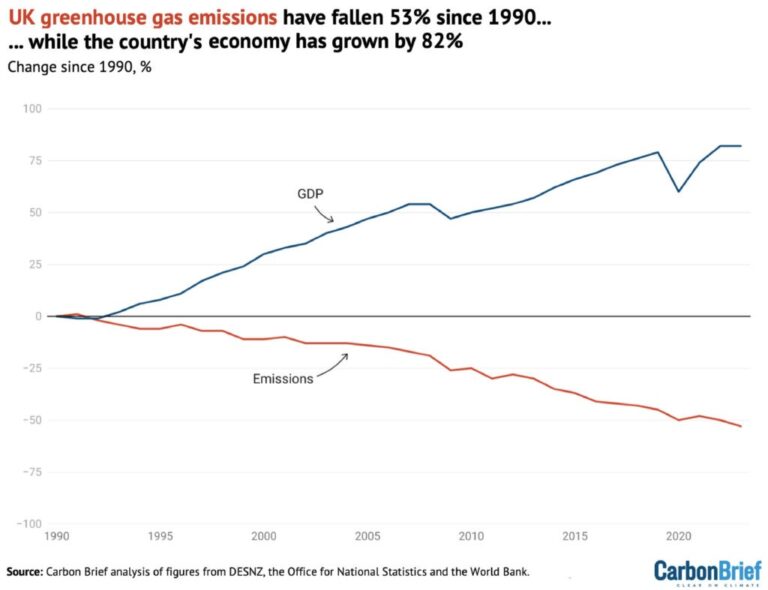
경제 ‘두배’로 성장, 탄소 ‘절반’ 감축
영국, 탄소배출 감축이 경제 위기 무관 입증
올들어 여러 차례 탈탄소 경제에 대해 칼럼을 이어갔다. 탄소배출을 줄이면 경제에 타격을 주지 않을까 라는 질문에 대안을 제시하기 위해서 였다. 탄소경제는 선진국을 지난 150년간 이끌어 온 경제의 근간이기 때문에 탄소 배출을 하지 않으려면 경제적인 큰 손실을 입거나 심지어 원시시대처럼 살아야 한다고 우려하는 사람들도 있다.
그러니 영국을 통해 탈탄소 경제의 실제적인 사례를 살펴보자. 영국의 저명한 탐사보도 전문지 카본 브리프 3월 11자에 따르면 영국의 온실가스 배출양은 지난해 3억8천만톤으로 캐나다나 한국의 절반이었다. 1879년 이후 최저치다. ‘1979’년이 아니라 그보다 100년 전인 ‘1879’년에 비해서다. 산업혁명 직후, 영국이 막 탄소를 뿜어내며 경제 발전을 시작할 무렵이란 뜻이다. 그 이후 약 150년만에 그 때로 돌아간 것이다.
카본 브리프지는 영국이 1990년 대비 GDP는 82% 증가한 대신 온실가스는 53%가 줄었다고 계산했다. 경제는 두배 가까이 성장했고 온실가스는 절반으로 줄었다. 이게 가능하다는 것을 실제로 보여주고 있다.
물론 정부의 정책 외에도 외부적인 요인도 작용을 한 바 있으나 지속적인 온실가스 배출 감소 추세는 이어지고 있다. 예를 들어 지난해는 평균 이상의 기온에다 우크라이나 전쟁으로 가스가격 상승의 영향으로 가스 수요가 11% 줄었다. 또 프랑스의 핵발전 전기를 더 많이 수입했다. 석탄화력발전소는 하나를 제외하고 모두 폐쇄 돼 석탄 사용량은 무려 300년 이전(1730년) 수준으로 돌아갔다. 석탄 화력 발전소는 단 한 곳을 제외하고 모두 폐쇄되면서 석탄 사용량은 2023년에 23% 감소하여 ‘1730’년대 이후 가장 낮은 수준으로 떨어졌다. 2012년만 해도 석탄발전소가 전체 전력의 42%를 감당했으나 탄소배출 감축을 위해 불과 10년만에 1%로 폭포수처럼 떨어지는 급격한 변화를 이뤄 냈다. 이 변화로 영국 전체 석탄수요의 87%가 줄어들었다. 그 남은 한 곳도 올 9월이면 폐쇄 된다.
발전 부문의 탄소 배출 감축으로 영국의 탄소 배출은 부문별로는 운송에서의 배출이 가장 높았고 뒤를 이어 건물, 산업, 농업, 발전 부문이 이어졌다.
물론 올해 다시 배출양이 다소 증가할 가능성이 없지는 않다. 프랑스에서 수입하는 핵발전 전기가 지속적으로 안정적으로 공급이 가능할지도 알 수 없다. 만약 2022년처럼 프랑스 핵발전이 광범위한 운영중단사태로 전기 수입이 매우 제한될 경우 가스 발전소를 늘여야 할 수도 있다.
또 2023년에도 풍력 및 태양광 발전 용량이 지속적으로 늘었으나 평균 풍속과 일조시간이 감소해 용량 증가의 효과를 충분히 볼 수 없었다. 그럼에도 영국은 2022년 스코틀랜드와 서머셋 핵발전소의 폐쇄와 유지보수 중단으로 핵 발전 생산량을 15%나 줄였다. 이에 따라 핵 발전량은 1980년대 이후 최저 수준으로 떨어졌으며 현재 가동중인 발전소는 5곳이다. 그 중 한 곳을 제외하고 10년 내 모두 영구 중단될 예정이다.
석탄의 경우, 가정, 철도, 공장, 발전소 등에서 지난 30년 간 꾸준히 수요가 줄어들었다. 물론 이런 변화가 가능한 데는 1970년대 이후 2차 산업대신 서비스산업으로 변환이 꾸준히 이뤄진 데도 이유가 있다. 2차산업을 유지 발전시키기 위해서는 더 많은 전력이 필요한데 재생에너지로만 감당하기에는 한계가 있을 수 있기 때문이다. 그럼에도 영국의 전력공급은 풍력31%, 원자력 15%, 수력, 바이오매스 9% 등 대부분이 재생에너지이며 천연가스 13%에다 부족분 30%를 프랑스 등 핵발전 전력을 수입하고 있다.
다만 교통 부문은 지속적인 교통량 증가로 자동차의 연료 효율성을 높이고 1백만대 이상의 전기차를 보급하면서도 온실가스 배출량 감축을 이루진 못하고 있다. 교통 부문은 영국 전체 온실가스 배출량의 3분의 1을 차지하고 있다.
영국은 이처럼 탄소배출을 급격히 줄이면서도 꾸준한 경제 성장을 보이고 있다. 현재 완만한 침체기를 맞고 있으며 올해도 1% 성장에 그칠 것으로 예상되지만 기후위기 반대론자들이 우려하는 것처럼 급격한 경제 붕괴 시나리오는 나타나지 않고 있다. 국제 전력시장, 기온변화 등으로 올해 탄소배출이 다시 약간 늘어날 가능성이 있음에도 정책적 결단으로 탈탄소 경제가 가능함을 영국은 보여주고 있다.
정필립
Economy ‘doubles’ while carbon cuts ‘halve’
UK proves that cutting carbon emissions isn’t causing economic crisis
I’ve written several times this year about the decarbonized economy. The idea is to provide an alternative answer to the question of whether reducing carbon emissions will hurt the economy. Because the carbon economy is the backbone of what has driven the developed world for the past 150 years, some people worry that if we don’t emit carbon, we’ll suffer major economic declines or even go back to living in the caveman era.
So let’s look to the UK for a real-world example of a decarbonized economy. According to the March 11 edition of the Carbon Brief, a prominent British investigative journal, the U.K. emitted 380 million tons of greenhouse gases last year, half as much as Canada or South Korea. It’s the lowest since 1879. Not “1979,” but “1879,” a century before that. That’s right after the Industrial Revolution, when the UK was just starting to develop its carbon-burning economy. It’s been about 150 years since then.
The Carbon Brief calculates that the UK has increased its GDP by 82% since 1990, while reducing greenhouse gas emissions by 53%. The economy has nearly doubled and greenhouse gases have been cut in half. It really shows that it’s possible.
Of course, there are external factors besides government policies that have played a role, but the trend of steadily decreasing greenhouse gas emissions continues. Last year, for example, gas demand fell by 11% due to above-average temperatures and higher gas prices as a result of the war in Ukraine. We also imported more electricity from nuclear power in France. All but one coal-fired power plant has closed, bringing coal use back to levels seen 300 years ago (1730). With all but one coal-fired power plant closed, coal use fell 23% in 2023, to its lowest level since the ‘1730s’. As recently as 2012, coal plants provided 42% of the country’s electricity, a dramatic shift that has cascaded down to 1% in just over a decade as the country tries to reduce carbon emissions. This shift has eliminated 87% of the UK’s total coal demand, with the last remaining plant set to close this September.
With the reduction in power generation, the UK’s carbon emissions have been reduced by sector, with the highest emissions coming from transportation, followed by buildings, industry, agriculture, and power generation.
Of course, it’s not impossible that emissions could rise again this year. We also don’t know if the nuclear electricity the UK imports from France will continue to be reliable. If French nuclear power suffers a widespread shutdown, as it did in 2022, and imports become very limited, gas plants may have to be ramped up.
Also in 2023, wind and solar capacity continued to increase, but average wind speeds and sunshine hours decreased, preventing the full benefit of the capacity increase. Nevertheless, the UK reduced nuclear power production by 15% in 2022 due to the closure and maintenance of nuclear power plants in Scotland and Somerset. As a result, nuclear power generation has fallen to its lowest level since the 1980s, with only five plants currently operating. All but one of them are expected to close in the next decade.
In the case of coal, demand has been steadily declining over the past 30 years in homes, railroads, factories, and power plants. This is, of course, due to the steady shift from secondary industries to services since the 1970s. This is because more power is needed to maintain and develop secondary industries, which can only be provided by renewables. Nevertheless, the UK’s electricity supply is mostly renewable (31% wind, 15% nuclear, 15% hydro, 9% biomass), with 13% natural gas and 30% imported nuclear power from France and other countries.
However, the transportation sector has not been able to reduce GHG emissions despite continued traffic growth, increasing the fuel efficiency of vehicles and deploying more than 1 million electric vehicles. The transportation sector accounts for one-third of the UK’s total greenhouse gas emissions.
The UK has been able to make such dramatic reductions in emissions while maintaining steady economic growth. It’s currently in a mild recession and is expected to grow by just 1% this year, but it’s not facing the kind of economic collapse that climate change deniers fear. The UK is showing that a decarbonized economy is possible with policy decisions, even though emissions are likely to rise slightly again this year due to international electricity markets and changing temperatures.
